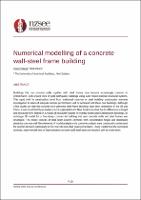| dc.contributor.author | Pascua, Claire | |
| dc.contributor.author | Henry, Rick | |
| dc.date.accessioned | 2021-06-22T04:02:06Z | |
| dc.date.available | 2021-06-22T04:02:06Z | |
| dc.date.issued | 2021-04-14 | |
| dc.identifier.uri | https://repo.nzsee.org.nz/xmlui/handle/nzsee/2427 | |
| dc.description.abstract | Buildings that use concrete walls together with steel frames have become increasingly common in Christchurch, with around 35% of post-earthquake buildings using such mixed-material structural systems. This rapid shift in construction trend from traditional concrete or steel building construction warrants investigation to assess if adequate seismic performance will be achieved with these new buildings. Although a few studies on high-rise concrete core-perimeter steel frame buildings have been undertaken in the US and China, it was found that these studies are not applicable to the New Zealand context due to differences in height and structural form. Based on a review of structural features in recently constructed Christchurch buildings, an archetype 2D model for a five-storey commercial building that uses concrete walls and steel frames was developed. The model consists of steel beam-column elements with concentrated hinges and distributed plasticity concrete wall fibre elements. A modal analysis and a pushover analysis were conducted to understand the seismic demands particularly at the concrete wall-steel beam connections. Using results from the numerical analyses, experimental tests of representative concrete wall-steel beam connections will be undertaken. | |
| dc.language.iso | en | |
| dc.publisher | New Zealand Society for Earthquake Engineering | |
| dc.relation.ispartofseries | 2021;0177 | |
| dc.subject | Improving resilience of lifelines and infrastructure | |
| dc.subject | Advancements in structural and geotechnical design and assessment | |
| dc.title | Numerical modelling of a concrete wall-steel frame building | |
| dc.type | Article | |

